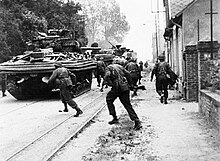The land forces employed by the United Kingdom during the Falklands War amounted to a divisional sized formation, named as Land Forces Falkland Islands, consisting of two brigades:
- 3 Commando Brigade - formed primarily by the Royal Marines, 3 Commando Brigade was the
 primary British rapid reaction force, tasked with reinforcing the NATO northern flank in Norway in the event of war with the Soviet Union in Europe. 3 Commando Brigade was the formation with most experience of amphibious operations. In its NATO role, 3 Commando Brigade was reinforced by the Dutch Korps Mariniers. However, the situation required reinforcement by British units, with the result that 2nd & 3rd Battalions of the Parachute Regiment were reassigned from 5 Infantry Brigade.
primary British rapid reaction force, tasked with reinforcing the NATO northern flank in Norway in the event of war with the Soviet Union in Europe. 3 Commando Brigade was the formation with most experience of amphibious operations. In its NATO role, 3 Commando Brigade was reinforced by the Dutch Korps Mariniers. However, the situation required reinforcement by British units, with the result that 2nd & 3rd Battalions of the Parachute Regiment were reassigned from 5 Infantry Brigade.
- 5 Infantry Brigade - the UK's main "out of area" reaction formation, tasked with operations outside the European theatre. At the time, it would normally be formed using two battalions of the Parachute Regiment, together with the UK based Gurkha battalion. However, since both 2 PARA and 3 PARA were used to reinforce 3 Commando Brigade for the initial landings in the Falklands, 5 Brigade was reinforced with two battalions of foot guards then on public duties in London. These were chosen as they were immediately available, as they were neither on internal security duties in Northern Ireland nor attached to BAOR.

Some of the weapons used in the Falklands War had never been used in combat action before such as the British, carrier-based, VTOL Sea Harrier aircraft and the French Exocet anti-ship missile (launched from the French-made Argentine Super Étendard.
Others, like the FAL infantry rifle and the 120mm mortar had already seen combat action in former armed conflicts, such as the anti-insurgent operations against leftist guerrillas in the Northwest region of Argentina.
The FN FAL was the standard-issue infantry rifle used by both sides. It was a 7.62mm, gas-operated, automatic rifle designed by the Belgian firm Fabrique Nationale (FN). The acronym FAL stands for the French "Fusil Automatic Légere", which means Light Automatic Rifle (LAR) in English. It shot the 7.62x51mm NATO cartridge and had an effective range of 300 m. This rifle was fed by a 20-round box magazine and was fitted with iron sights.Used both by the Argentine Army Infantry and the British forces, the 7.62mm-caliber FN MAG (Mitrailleuse d’Appui Général) machine gun was another product of the Belgian factory Fabrique Nationale. It was also chambered for the 7.62x51mm NATO ammunition. It had a rate of fire of about 700 rpm. This was the machine gun with which the Argentines raked the slopes of Darwin, Two Sisters, and Mount Harriet hills from their machine gun nests set up among the rocks on top as the British paras and Royal Marines courageously charged up at them.To destroy the bunkers and machine gun nests and be able to advance, the British troops resorted to an anti-tank weapon, the Milan, a wire-guided missile which had been in service since 1972. It turned out to be a very effective weapon against the Argentinian bunkers.
(Mitrailleuse d’Appui Général) machine gun was another product of the Belgian factory Fabrique Nationale. It was also chambered for the 7.62x51mm NATO ammunition. It had a rate of fire of about 700 rpm. This was the machine gun with which the Argentines raked the slopes of Darwin, Two Sisters, and Mount Harriet hills from their machine gun nests set up among the rocks on top as the British paras and Royal Marines courageously charged up at them.To destroy the bunkers and machine gun nests and be able to advance, the British troops resorted to an anti-tank weapon, the Milan, a wire-guided missile which had been in service since 1972. It turned out to be a very effective weapon against the Argentinian bunkers.
 (Mitrailleuse d’Appui Général) machine gun was another product of the Belgian factory Fabrique Nationale. It was also chambered for the 7.62x51mm NATO ammunition. It had a rate of fire of about 700 rpm. This was the machine gun with which the Argentines raked the slopes of Darwin, Two Sisters, and Mount Harriet hills from their machine gun nests set up among the rocks on top as the British paras and Royal Marines courageously charged up at them.To destroy the bunkers and machine gun nests and be able to advance, the British troops resorted to an anti-tank weapon, the Milan, a wire-guided missile which had been in service since 1972. It turned out to be a very effective weapon against the Argentinian bunkers.
(Mitrailleuse d’Appui Général) machine gun was another product of the Belgian factory Fabrique Nationale. It was also chambered for the 7.62x51mm NATO ammunition. It had a rate of fire of about 700 rpm. This was the machine gun with which the Argentines raked the slopes of Darwin, Two Sisters, and Mount Harriet hills from their machine gun nests set up among the rocks on top as the British paras and Royal Marines courageously charged up at them.To destroy the bunkers and machine gun nests and be able to advance, the British troops resorted to an anti-tank weapon, the Milan, a wire-guided missile which had been in service since 1972. It turned out to be a very effective weapon against the Argentinian bunkers.
No comments:
Post a Comment